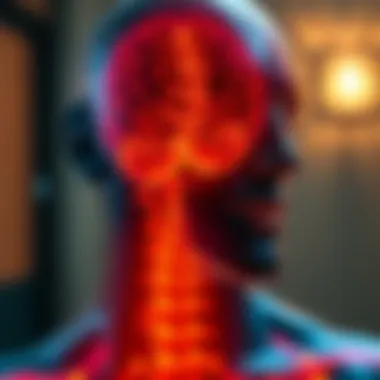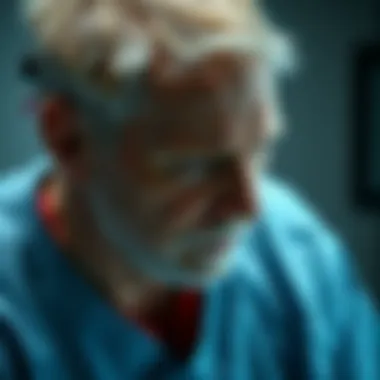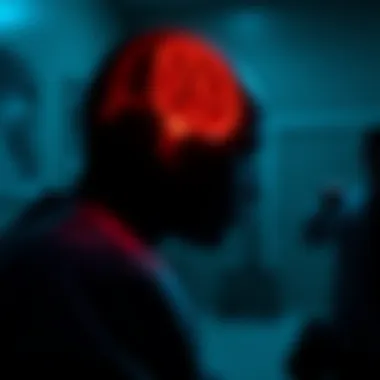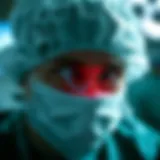Understanding Post-Stroke Pain Syndrome and Its Effects


Intro
Post-stroke pain syndrome is a puzzling and often overlooked aspect of stroke recovery. While stroke survivors manage physical and cognitive challenges, many struggle silently with pain that seems to arise out of nowhere. The experience of such pain, characterized by its varying types and intensities, can significantly color their quality of life. Each story is unique, weaving layers of personal struggle and resilience into the fabric of recovery. This article probes the complexities of post-stroke pain syndrome, not just to inform, but also to advocate for a more nuanced understanding of its implications on patients’ lives.
The nuances of this syndrome are critically important as they inform treatment approaches and patient care strategies. A pain that many dismiss or misunderstand can lead to significant psychological distress, creating a vicious cycle that hinders rehabilitation. It’s essential to unpack these complexities by exploring various facets, including definitions, mechanisms, prevalence, and the personal experiences of those affected. By doing so, we can create a clearer picture, spotlighting the importance of individual responses to pain and consequently urging tailored interventions.
As we navigate through this discussion, the significance of aligning treatment methods with patients’ unique needs will become evident. This allows us to focus not only on the physical symptoms but also on the emotional aftermath of stroke and its painful remnants. As we delve deeper, let's first shine a light on the methodologies that frame our understanding of post-stroke pain syndrome.
Defining Post-Stroke Pain Syndrome
Understanding post-stroke pain syndrome is crucial to enhancing the overall quality of life for stroke survivors. This knowledge ultimately influences effective rehabilitation and recovery strategies, leading to better patient outcomes.
Understanding Stroke and Its Aftermath
A stroke occurs when the blood supply to a part of the brain is interrupted or reduced, often resulting in brain damage. Following a stroke, a patient may experience a spectrum of physical and psychological effects. Many individuals recover capabilities like movement and communication, but others are left grappling with persistent symptoms, one of which is pain.
Post-stroke pain, often seen in varying intensities and areas of the body, is not merely an unpleasant ordeal; it reshapes lives. This condition springs from the damage to specific areas in the brain that manage pain signals. It’s not always straightforward. For some people, the pain might appear right after the stroke, while others experience it months or even years later. The complexities surrounding the aftermath of a stroke mean that caretakers and loved ones must be vigilant in recognizing subtle cues indicating discomfort or distress.
What Constitutes Post-Stroke Pain Syndrome
Post-stroke pain syndrome comprises different types of pain that can manifest in survivors, each influenced by unique neurological changes and factors. It generally falls into three main categories: central pain, nociceptive pain, and psychogenic pain.
- Central Pain: This occurs due to malfunctioning pain pathways in the brain. It may feel like burning, aching, or tingling, often starting in one side of the body and can become chronic.
- Nociceptive Pain: Resulting from stimulation of pain receptors, this type can emerge from muscle tightness, joint issues, or even pressure sores. It reflects physical causes that need to be addressed through proper management.
- Psychogenic Pain: Often overlooked, this condition intertwines emotional factors with physical pain. It highlights the necessity of considering psychological health when tackling post-stroke challenges.
Recognizing the distinct components of post-stroke pain syndrome leads to more tailored approaches to treatment, emphasizing the need for an individualized care plan.
"Understanding and addressing the various types of pain in stroke survivors is not simply a medical necessity; it’s a crucial aspect of their lived experience."
Ultimately, defining post-stroke pain syndrome allows healthcare professionals, families, and caregivers to devise targeted interventions, assisting stroke survivors in navigating their complex pain landscapes.
Prevalence and Impact
Understanding the prevalence and impact of post-stroke pain syndrome is crucial for both medical professionals and the families of stroke survivors. This segment sheds light on the extent of this condition and its ramifications on patients’ daily lives. Grasping these elements can aid in better management approaches and foster empathy among caregivers and peers.
Incidence Rates of Post-Stroke Pain
Various studies have illustrated that approximately 30% to 50% of stroke survivors experience some form of post-stroke pain. The discomfort can stem from diverse sources, manifesting in different ways and affecting recovery. The pain can emerge immediately after the stroke or even several months later, creating a challenging timeline for healing.
For instance, a stroke survivor may find their left arm constantly tingling or feel a strong burning sensation in their lower extremities. Such symptoms can not only detract from quality of life but also complicate rehabilitation efforts. The persistence of pain can hinder engagement with therapy and other rehabilitation exercises, which are crucial during recovery.
Moreover, multiple factors influence the risk of developing post-stroke pain.
- Type of Stroke: Ischemic strokes tend to have different pain profiles than hemorrhagic strokes.
- Age and Gender: Younger stroke survivors may experience different pain patterns compared to older adults. Interestingly, some research suggests that women report higher pain levels than men.
- Pre-existing Conditions: Individuals with prior chronic pain or neurological disorders may be at an elevated risk.
"Understanding the nuances of post-stroke pain is vital. It can significantly limit a patient’s ability to participate in their recovery journey."
The Economic and Social Burden
The implications of post-stroke pain extend far beyond individual discomfort. From a societal perspective, the condition imposes a heavy economic burden. The costs associated with treatment, rehabilitation, and long-term care can escalate quickly. Estimates suggest that post-stroke pain can add more than $15 billion annually in healthcare costs, including hospitalizations and outpatient treatments. This financial strain is compounded by lost workforce productivity and increased caregiver support needs.
Additionally, the social implications are equally disquieting. Individuals grappling with persistent pain often experience social isolation. Friends and family may not fully comprehend the severity of the problem, leading to misunderstandings and strained relationships. Participating in social events can become daunting, as stroke survivors may worry about how their pain will limit their activities or willingness to engage. This isolation only serves to magnify the psychological complications already faced, such as depression or anxiety.
In summary, grasping both the incidence rates and the broader economic and social implications of post-stroke pain is not merely a matter of statistics. It represents a call to action for caregivers, healthcare professionals, and policymakers alike. Creating a supportive framework for those affected can mitigate both immediate and long-term challenges, leading to better patient outcomes.
Mechanisms of Pain Development
Understanding the mechanisms behind post-stroke pain syndrome is critical for both effective diagnosis and treatment. In many cases, pain can be debilitating and affects the psychological well-being of survivors. Recognizing how pain develops provides insight into tailored therapeutic strategies that consider individual needs. This section will delve into the neurological and psychological aspects that contribute to post-stroke pain, assigning importance to multifactorial nature of this syndrome and driving home the necessity for a nuanced approach.
Neurological Underpinnings of Pain Signals
The relationship between the brain and pain perception is complex. After a stroke, changes can occur within the nervous system that may cause pain through abnormal signaling. Numerous studies have documented alterations in nociceptive pathways, which are the conduits for pain signals from the periphery to the brain. When a stroke occurs, the brain's structure is compromised, leading to dysfunctional signaling.


For example, the lateralization of pain processes can become uneven post-stroke—meaning one side of the brain may process pain signals more intensely than the other. Additionally, central sensitization may occur. This phenomenon happens when the central nervous system becomes overly responsive, resulting in pain amplification even in response to non-painful stimuli.
- Key factors include:
- Dysregulation of neurotransmitters: Neurotransmitters like glutamate and substance P may play increased roles in amplifying pain.
- Reorganization of neural pathways: The brain may try to adapt by reorganizing connections, sometimes leading to increased pain perception.
Understanding these mechanisms allows clinicians to approach treatments more effectively. For instance, targeting specific neurotransmitter systems with pharmacological interventions can mitigate pain by restoring balance to these neural pathways. Here, a thorough understanding becomes a double-edged sword—while it offers pathways for effective treatments, it also underscores the complexities of how pain is felt by stroke survivors, which impacts their recovery trajectories.
Psychological Contributions to Pain Perception
Psychological factors cannot be ignored when discussing post-stroke pain. The mind is a powerful player in how we experience pain. For stroke survivors, the emotional toll is profound and can exacerbate their pain experience. The feelings that accompany recovering from neurological trauma—such as fear, anxiety, and depression—often intertwine with pain syndromes.
Research highlights several ways in which psychological components feed into the perception of pain:
- Cognitive appraisal: How an individual interprets their pain can dictate their emotional response. If a stroke survivor perceives their pain as a threat to their well-being, it can create a cycle of anxiety that intensifies the pain experience.
- Coping mechanisms: Survivors with better coping strategies might experience pain differently. Effective coping can foster resilience, whereas maladaptive strategies could contribute to an exacerbation of pain.
Furthermore, conditions like post-traumatic stress disorder (PTSD) may arise after a stroke, further complicating pain management. Pain can serve as a constant reminder of trauma, creating a feedback loop that compounds both psychological distress and physical suffering.
"Cognitive and emotional responses to pain can shape the outcomes of rehabilitation, making psychological interventions just as crucial as physical treatments."
In summary, understanding the psychological aspects offers greater depth into the treatment of post-stroke pain. Interventions may need to integrate psychological support, which in many cases equates to more effective recovery outcomes for individuals.
The mechanisms behind post-stroke pain—both neurological and psychological—present a multi-dimensional opportunity for research and therapeutic innovation. Addressing these aspects effectively can pave the way for improved quality of life for stroke survivors.
Types of Post-Stroke Pain
Understanding the various types of pain experienced by stroke survivors is crucial for a holistic approach to treatment and rehabilitation. The complexity of post-stroke pain syndrome isn’t just about the pain itself; it encompasses how this pain manifests and its impact on each individual. By dissecting the specific types of pain—central pain, nociceptive pain, and psychogenic pain—we can tailor interventions effectively, aiming for better management and improved quality of life.
Central Pain: Mechanisms and Characteristics
Central pain originates from damage to the brain or spinal cord, typically a result of the stroke itself. This type of pain can be particularly perplexing, as it arises without any clear physical injury to the body. The mechanisms behind central pain are rooted in the neuroplastic changes that occur following a stroke. Neurons adapt in ways that can create abnormal pain sensations, often leading to phenomena like allodynia, where non-painful stimuli become painful.
Individuals experiencing central pain may describe it as burning, aching, or electrical-like sensations that can be quite distressing. These sensations can vary in intensity and can be triggered by various factors, such as temperature changes or even sensations that shouldn't ordinarily cause pain. Recognizing these characteristics is vital for healthcare professionals to develop suitable management strategies.
Nociceptive Pain: Understanding Its Role
Nociceptive pain refers to pain that arises from actual damage or potential damage to body tissue. For stroke survivors, this can include pain from muscle spasticity, joint pain from immobility, or injuries sustained during the stroke. Unlike central pain, nociceptive pain often has clear physiological causes.
Clinically, it’s essential to distinguish nociceptive pain from other pain types in order to focus management accordingly. For instance, interventions such as physical therapy may be particularly effective here. Addressing nociceptive pain not only improves comfort but can also aid in the recovery process by promoting movement and rehabilitation efforts. The role of nociceptive pain becomes even more significant considering that untreated pain can inhibit patients' motivation to engage in necessary rehabilitation activities.
Psychogenic Pain: The Overlooked Component
Psychogenic pain stems from psychological factors rather than physical injury. This form of pain is often dismissed, even though it can be just as debilitating as physical pain. Stroke survivors might experience psychogenic pain due to the emotional and psychological upheaval that follows a stroke. Feelings of anxiety, depression, and frustration can manifest as physical pain.
It’s sadly common for healthcare systems to overlook psychogenic contributions to pain, which can further complicate treatment. Understanding and addressing these factors through psychological support and counseling can play a significant role in a patient’s recovery journey. Balancing psychiatric and physical care is essential for a comprehensive pain management plan.
In summary, recognizing the different types of post-stroke pain is essential for effective intervention. Each pain type requires tailored management strategies, considering the unique experiences of stroke survivors. To provide thorough and effective recovery, healthcare professionals must adopt a nuanced understanding of the pain landscape.
Diagnostic Approaches
Determining the presence of post-stroke pain syndrome involves a nuanced and methodical diagnostic process. By employing a set of well-founded techniques, healthcare professionals aim to enhance both the accuracy of the diagnosis and the efficacy of subsequent treatments. Recognizing pain can sometimes be as intricate as untangling a ball of yarn; it requires patience, attention to detail, and often a collaborative approach. Let's delve into the specifics of how clinicians navigate this territory.
Clinical Assessment Techniques
When it comes to assessing post-stroke pain, subjective evaluations often become the backbone of the clinical assessment. First and foremost, thorough patient interviews play a vital role. Healthcare providers typically engage patients in discussions to understand the history and nature of their pain. This allows them to explore elements such as:
- Pain Location: Knowing exactly where it hurts can help pinpoint potential neurological involvement.
- Pain Quality: Is the pain sharp, throbbing, or burning? The quality can provide clues about the underlying mechanisms.
- Duration of Symptoms: Identifying if the pain is acute, chronic, or fluctuates can influence treatment decisions.
Additionally, questionnaires and standardized pain scales are often utilized for a more structured approach to symptom evaluation. Scales like the Visual Analog Scale (VAS) can help in quantifying the patient’s pain experience on a simple scale of 1 to 10. This process not only aids in making precise diagnoses but can also serve as a benchmark for treatment effectiveness.
Another essential element of clinical assessment involves a physical examination. By assessing the patient's physical reflexes and conducting neurological evaluations, practitioners can gather critical data regarding the motor and sensory functions. The outcomes could indicate how the stroke has impacted neural pathways and inform the potentiality for pain developments.


Utilizing Imaging and Neurological Testing
Imaging and neurological tests are crucial in the diagnosis of post-stroke pain syndrome. While clinical evaluations provide preliminary insights, imaging techniques like MRI or CT scans can reveal structural or functional changes in the brain—an aspect that could be responsible for the pain. For example, brain scans can uncover areas of damage or alterations in pathways that might not be evident through patient interviews or physical assessments alone.
- MRI (Magnetic Resonance Imaging): High-resolution imaging that offers a detailed view of brain structures, and it’s particularly sensitive to changes in soft tissue. Studies have shown it can detect subtle abnormalities that may correlate with the experience of pain.
- CT (Computed Tomography) Scans: Often utilized in acute care settings, particularly to rule out other conditions, such as bleeding or additional strokes that could complicate the pain assessment.
Moreover, neurological testing can provide additional information on brain activity and its correlation with pain pathways. Electrophysiological tests, including Electroencephalography (EEG) or nerve conduction studies, can assess the function of the nervous system. This entire approach transforms a fragmented pain experience into a clearer picture, enabling tailored management strategies.
Through these diagnostic approaches, it becomes possible to build a comprehensive understanding of each patient's situation. Ultimately, the goal remains: to tailor interventions that not only ameliorate pain but also enhance the quality of life for those navigating the complex aftermath of a stroke.
Therapeutic Strategies
Therapeutic strategies for post-stroke pain syndrome play a vital role in enhancing the overall recovery process for stroke survivors. They encompass various methods and techniques tailored to address the underlying causes and manifestations of pain. More than just alleviating discomfort, these strategies aim to restore mobility, improve quality of life, and aid psychological adjustment. A comprehensive approach, incorporating pharmacological, physical, and psychological interventions, can yield the best outcomes for individuals affected by this condition.
Pharmacological Interventions
Medicinal treatments for post-stroke pain often start with conventional pain relievers. Nonsteroidal anti-inflammatory drugs (NSAIDs) like ibuprofen or naproxen can provide immediate relief and are typically among the first lines of treatment. However, as pain varies widely from patient to patient, more targeted medications may be necessary.
Antidepressants and anticonvulsants, for example, are proving useful in managing neuropathic pain. Medications such as gabapentin or amitriptyline work by dampening the pain signals transmitted through the nervous system. In some cases, stronger options, like opioids, might be prescribed cautiously, keeping in mind their potential for dependence and adverse effects. While the pharmaceutical landscape offers many choices, it’s essential for providers to regularly assess each patient’s experience and side effects to optimize therapy.
"Effective management of post-stroke pain is paramount for enhancing recovery and overall patient satisfaction."
Physical Rehabilitation Techniques
Physical rehabilitation forms a cornerstone of therapeutic efforts aimed at post-stroke pain syndrome. The focus during rehabilitation is twofold: relieving pain and restoring function.
Specific techniques might include:
- Targeted Exercise Programs: Tailored exercises can help mitigate pain and promote muscle strength. For instance, stretching facilitates the expungement of tension in the muscles, promoting better mobility.
- Manual Therapy: Techniques such as massage, chiropractic adjustments, or acupuncture can decrease pain by improving blood flow and reducing muscle stiffness.
- Occupational Therapy: This encourages individuals to engage in daily activities, reinforcing both physical capacity and psychological well-being. Even small achievements in mobility can significantly uplift a stroke survivor’s spirits.
It is important to recognize that rehabilitation approaches should be personal. What works wonders for one individual may not suit another. Continuous evaluation and adjustment of strategies lead to more successful outcomes.
Psychological Counseling and Support
While tackling the physical symptoms of post-stroke pain is crucial, addressing psychological aspects is equally important. The mental toll that living with chronic pain can exert leads to an increased risk of depression, anxiety, and isolation.
Counseling can provide a safe space for stroke survivors to express their feelings and frustrations. Therapists trained in cognitive-behavioral strategies can assist in reframing negative thought patterns and promoting coping strategies. Support groups often play a role in this context, offering survivors a chance to connect with peers who share similar struggles.
Ultimately, enabling a patient to understand that their feelings are valid can foster a sense of control over their situation. Integrating psychological support with other therapeutic strategies can lead to a more well-rounded recovery approach, enhancing the likelihood of improving both mental health and pain management.
Individual Variations in Pain Experience
Understanding how post-stroke pain is perceived and experienced can vary tremendously between individuals. This isn't just a matter of personal psychology or tolerance; rather, it's a complex interplay of multiple factors — biological, genetic, and sociocultural. By delving into these individual variations in pain experience, we can better grasp the multifaceted nature of post-stroke pain syndrome and, in turn, improve treatment methodologies.
The implications of these variations extend far beyond mere clinical observations. They allow for a deeper comprehension of how personalized care plans can be more effectively designed. Individuals who suffer from post-stroke pain may not only benefit from tailored treatments but also find validation and an understanding of their experience, which is often overlooked in traditional approaches. This section aims to elucidate the significant aspects governing these variations by examining both genetic and cultural influences on pain perception.
The Role of Genetics and Biology
Genetics and biology play crucial roles in determining how each person perceives pain after a stroke. For example, variations in certain genes can influence pain sensitivity, pain threshold, and even the way pain is processed by the nervous system.
- Genetic Polymorphisms: Sometimes, variations in genes that code for certain receptors in the brain can make a person more susceptible to chronic pain. Research has found specific gene polymorphisms that correlate with different pain responses.
- Nerve Plasticity: After a stroke, nerve regeneration and plasticity might operate differently in each individual, affecting how pain signals are sent and processed.
A better grasp on these biological differences may fuel the development of more effective pharmacological treatments. Customizing medication according to an individual’s genetic makeup is a concept gaining traction in the field of personalized medicine.
Cultural and Societal Influences
Beyond biology, one cannot ignore the impact of culture and society on pain experience. Cultural beliefs shape the very way individuals interpret and respond to pain. Factors to consider include:
- Pain Expression: Different cultures may have varying norms regarding how pain is expressed. This can range from open displays of distress to stoic tolerance, and affects how pain is reported in clinical settings.
- Healthcare Systems: Access to healthcare and cultural stigma surrounding medical treatment can vary significantly. People from some backgrounds might delay seeking help due to cultural beliefs about self-sufficiency or mental health.
- Family Dynamics: In some societies, family plays a pivotal role in caregiving and emotional support. This can either enhance or detract from a person’s ability to cope with pain, depending on the nature of the familial relationship.
Ultimately, recognizing the bearings of societal context is imperative for tailoring effective pain management strategies. A deeper understanding of both genetic predispositions and cultural narratives can lead to more compassionate and effective approaches.


"Pain is real, but the experience of pain is shaped by various internal and external factors that should not be overlooked in treatment plans."
In summary, acknowledging the individual nuances in pain perception is essential for advancing treatment effectiveness and enhancing patient experiences throughout their recovery.
Long-Term Outcomes and Recovery
The exploration of long-term outcomes and recovery in the context of post-stroke pain syndrome is crucial. Understanding the aftermath of a stroke goes beyond physical healing; it encompasses a wide array of experiences relating to pain, emotional challenges, and the overall quality of life. After a stroke, patients may battle chronic pain, which in turn can complicate their recovery and rehabilitation efforts.
Post-Stroke Pain and Quality of Life
Quality of life (QoL) stands as a significant concern for stroke survivors, many of whom find themselves dealing with debilitating pain long after the initial event. Chronic pain is not merely a physical ailment; it can lead to depression, anxiety, and social withdrawal. **Here are some key elements to ponder on regarding QoL: **
- Physical Limitations: Pain often restricts mobility, frustrating efforts to regain independence.
- Emotional Impact: Persistent pain can sap a person's motivation and lead to an array of psychological issues including low self-esteem.
- Social Isolation: Those suffering from chronic pain may withdraw from social activities, leading to loneliness and further mental health challenges.
The relationship between post-stroke pain and quality of life is complex and merits deeper exploration. As clinicians and caregivers aim to improve QoL for stroke survivors, addressing pain is vital. Comprehensive pain management strategies can lead to significant enhancements in physical and emotional well-being.
The Journey of Recovery: A Multi-Faceted Approach
Recovery from a stroke and the associated pain is not a one-size-fits-all scenario. Each individual’s journey is unique, shaped by an array of factors ranging from the type and severity of the stroke to personal resilience and support systems. A multi-faceted approach in treatment and rehabilitation can facilitate better outcomes for patients. Consider the following components:
- Interdisciplinary Collaboration: Involving a range of healthcare professionals—including physiotherapists, occupational therapists, and mental health specialists—is essential for comprehensive care.
- Customized Treatment Plans: Recovery strategies must be personalized. What works wonders for one patient may not yield the same results for another.
- Holistic Therapies: Physical therapies, psychological counseling, and even holistic approaches such as acupuncture or mindfulness can be integrated successfully.
- Family Involvement: Engaging families in the recovery process fosters a support system that can greatly enhance the patient's journey.
"Recovery is a highly individual journey, nuanced by pain management and overall emotional health. Each step taken forward is a triumph."
Investing time and resources into understanding these elements of recovery can ultimately lead to not only diminished pain but also improved quality of life for stroke survivors. Long-term outcomes hinge on a recognition of the complexity of pain, underscoring the necessity of tailored, compassionate care.
For further insights, one may refer to Wikipedia's article on Stroke Recovery and related resources.
Future Directions in Research
Research into post-stroke pain syndrome has come a long way, yet many avenues remain uncharted. Understanding the complexities of this condition is pivotal, as it can enhance recovery trajectories and improve the overall quality of life for survivors. The glaring need for further exploration is not only about refining existing treatments but also about exploring innovative therapeutic options and methodologies that can better address the multifaceted nature of post-stroke pain.
One of the primary reasons this research is crucial lies in its potential to unveil new therapeutic pathways. Researchers are increasingly driven to discover emerging therapies that can minimize pain while addressing the underlying neurological impairments caused by strokes. While traditional pain management approaches such as medications have their place, they often fall short of providing long-lasting relief for all patients. By delving into novel therapies, we might better cater to individual pain responses, thus paving the way for tailored treatment plans.
Emerging Therapies and Technologies
The frontier of healthcare is continually evolving, with new technologies and therapies surfacing that might transform the management of post-stroke pain syndrome. Neuromodulation techniques, such as transcranial magnetic stimulation and spinal cord stimulation, present promising approaches. These modalities act on the nervous system's circuitry to help alleviate pain without resorting to systemic medications, which can sometimes lead to undesirable side effects.
Moreover, breakthroughs in biotechnology, such as using stem cells, have shown potential in regenerating damaged neural tissues. Although still largely in experimental stages, these therapies hint at a future where we might not only manage pain but also fundamentally alter its genesis at a biological level. Consideration of cognitive behavioral therapies as adjunct treatments is also a significant direction; these techniques focus on the mind's role in affecting pain perception and can lead to improved coping strategies for survivors.
"New technologies could redefine how we approach post-stroke pain, offering hope where traditional methods have faltered."
The Importance of Interdisciplinary Studies
True progress in addressing post-stroke pain syndrome necessitates an interdisciplinary approach. Different fields such as neurology, psychology, pain management, and rehabilitation must collaborate to tackle this complex problem effectively. Each discipline provides a unique perspective and specific expertise that can contribute to a holistic understanding and treatment of pain.
For instance, neurology brings insight into the underlying mechanisms of pain signaling, while psychology offers understanding into emotional and cognitive facets, often complicating pain experiences. Rehabilitation experts can tailor physical therapies that coincide with these insights, ensuring the recovery process is comprehensive and responsive to individual needs.
Furthermore, combining insights from diverse disciplines can lead to the development of integrated care models, emphasizing the interconnectedness of physical and mental health. This coalition of expertise fosters a learning environment where innovative research questions can emerge, leading to better patient outcomes and thus, a more effective healthcare response to post-stroke pain syndrome.
End
The culmination of any thorough examination is always significant, but in the case of post-stroke pain syndrome, it carries an enormous weight. Recognizing how this condition profoundly affects individuals post-stroke is imperative. Patient care and rehabilitation hinge on a nuanced understanding of the complexities surrounding post-stroke pain. The quality of life for stroke survivors often dwindles under the burden of persistent pain, prompting clinicians, researchers, and caregivers to adopt comprehensive approaches tailored to each individual.
Summarizing Insights on Post-Stroke Pain Syndrome
In weaving together the insights gained throughout this article, it's essential to highlight several key points:
- Nature of Pain: Post-stroke pain is multifaceted. It encompasses central mechanisms, nociceptive responses, and even psychogenic influences.
- Diagnosis Matters: A precise and timely diagnosis remains the cornerstone of any treatment plan. Various assessment techniques exist, and understanding which to apply is crucial for effective management.
- Therapeutic Strategies: While pharmacological interventions are often the first line of defense, incorporating physical rehabilitation and psychological counseling can lead to better outcomes.
- Individual Variability: Not all patients experience pain in the same way. Factors such as genetics, psychological state, and societal influences play critical roles in shaping each person’s experience of pain.
This synthesis serves as a reminder of the intricate web that constitutes post-stroke pain syndrome. Each element, from the underlying biological mechanisms to the psychological implications, requires careful consideration.
Call for Continued Research and Support
As we turn our gaze to the future, the call for further research and support in the realm of post-stroke pain syndrome cannot be overstated. Continued studies are essential for teasing apart the complexities of this condition. Potential areas for deeper exploration include:
- Interdisciplinary Collaboration: Bringing together neurologists, psychologists, physical therapists, and pain specialists can foster mutually beneficial research pathways.
- Patient-Centric Approaches: Enhancing communication between healthcare providers and patients can lead to more personalized pain management strategies.
- Emerging Technologies: Advances in neuroimaging and genetic research might offer novel insights into this condition, paving the way for innovative treatment options.



